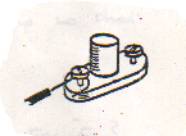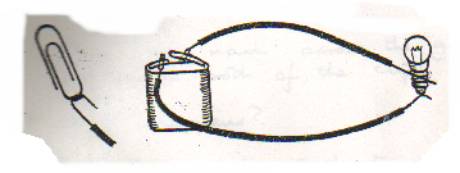|
Question: Can you tell me something about electrical conductors and suggest some simple experiments that could be done at home, suitable for Key Stage 2 of the UK National Curriculum? |
|
|
|
Answer: Materials
which can carry electric current are known as CONDUCTORS OF ELECTRICITY.
Materials which cannot carry electric current are known as NON-CONDUCTORS
OF ELECTRICITY It might be best to start your experiments on this topic by doing the following: Batteries and Bulbs
You will need: 4.5v battery Scrape the covering off the ends
of a 30cm length of wire. Twist one end round a paper clip. Do
the same with another 30 cm length of wire and another clip.
See what happens. You have made a simple electric circuit. Now screw the free ends of the wires to the terminals on the bulb holder and screw in the bulb. 
Cut through one of the wires. See what happens. Scrape the covering off the ends of the wire you have just cut. Twist each of these round a paper clip and press the two clips together. See what happens. What happens when you release your clips? See if you can write about what happens and why.
You will need: 4.5v battery First make an electric circuit similar to the one you have just made. Leave a small gap between the two paper clips which make up the switch.
Does the nail conduct electricity? Test other materials to see if they are conductors or non-conductors of electricity e.g. pin, pencil, hair clip, scissors, straw, silver paper, coin, rubber band, various metals, paper clip, finger. Now it might help to write about and draw diagrams about what you did and what you found out and to make a table of conductors and non-conductors. Remember: Materials which cannot carry electric current are known as NON-CONDUCTORS OF ELECTRICITY OR INSULATORS |
|
|

